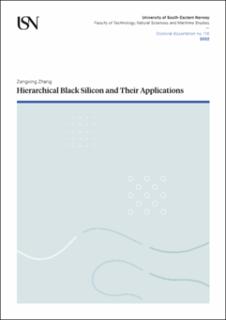| dc.contributor.author | Zhang, Zengxing | |
| dc.date.accessioned | 2022-01-07T07:37:46Z | |
| dc.date.available | 2022-01-07T07:37:46Z | |
| dc.date.issued | 2022 | |
| dc.identifier.isbn | 978-82-7206-636-8 | |
| dc.identifier.issn | 2535-5252 | |
| dc.identifier.uri | https://hdl.handle.net/11250/2836427 | |
| dc.description.abstract | Black silicon is expected to be a promising material for photoelectric, photothermic, photocatalytic, and microfluidic applications due to its remarkably anti-reflectivity, anti-bacterial effect, hydrophilicity, and hydrophobicity. These properties are attributed to the light trapping and surface tension interaction abilities of black silicon surface structures such as pores, pillars, cones, needles, and wires.
Conventional black silicon materials mainly have nanotextures with high aspect ratios and structural density. Nanotextures can be achieved through a series of fabrication approaches, including metal-assisted chemical etching, electrochemical etching, and reactive ion etching (RIE). However, few studies have focused on the surface texturing methodology of black silicon through microstructures.
Anti-reflection is the most critical factor defining the performance of black silicon in optical, photothermic, photochemical, and optoelectronic devices. The properties of these silicon-based devices under visible light illumination are commonly tuned through surface texturing, while their performance at wavelengths higher than 1100 nm requires either intrinsic lattice modification or enhancement by the addition of other materials.
Although a few studies have proposed combining micro and nanostructures, their research has focused on suppressing light reflection at wavelengths lower than 1100 nm. Unfortunately, the anti-reflectance of black silicon in the near-infrared (NIR) range (over 1100 nm) is still weak due to silicon’s intrinsic bandgap of 1.12 eV. Fortunately, recent advances in microfabrication and material engineering have enabled the in-depth exploration of the synergy between surface texturing and material reinforcement.
Therefore, building upon innovative fabrication approaches that enable novel black silicon with multi-scale surface structures and the investigation of their optical properties to create new silicon substrate materials for the next generation of photovoltaic, photodetector, and microfluidic devices is the motivation of this work. This Ph.D. work focuses on the following challenges: (1) Development of novel black silicon surface structure designs and relevant fabrication technologies. (2) Investigation and improvement of the optical properties of novel black silicon through the synergistic effect of surface texture and material reinforcement with localized surface plasmon resonance-inducing Au nanoparticles. (3) Exploration of the potential applications of the as-fabricated black silicon materials. | en_US |
| dc.language.iso | eng | en_US |
| dc.publisher | University of South-Eastern Norway | en_US |
| dc.relation.ispartofseries | Doctoral dissertations at the University of South-Eastern Norway;116 | |
| dc.relation.haspart | Article 1: Z.Zhang et al., “Black silicon with order-disordered structures for enhanced lighttrapping and photothermic conversion,” Nano Energy, vol. 65, no. June, p. 103992, 2019, doi: 10.1016/j.nanoen.2019.103992 | en_US |
| dc.relation.haspart | Article 2: Z.Zhang et al., “Ultralow Broadband Reflectivity in Black Silicon via Synergy betweenHierarchical Texture and Specific-Size Au Nanoparticles,” Adv. Opt. Mater., vol. 8, no. 19, 2020, doi: 10.1002/adom.202000668 | en_US |
| dc.relation.haspart | Article 3: Z.Zhang et al., “Fabrication of needle-like silicon nanowires by using a nanoparticles-assisted Bosch process for both high hydrophobicity and anti-reflection,” Micromachines. https://doi.org/10.3390/mi12091009 | en_US |
| dc.relation.haspart | Article 4: Z.Zhang, K. Du, X. Chen, C. Xue, and K. Wang, “An air-cushion triboelectricnanogenerator integrated with stretchable electrode for human-motion energy harvesting and monitoring,” Nano Energy, vol. 53, no. June, pp. 108–115, 2018, doi: 10.1016/j.nanoen.2018.08.011 (Not included in this thesis) | en_US |
| dc.relation.uri | http://creativecommons.org/licenses/by-nc-sa/4.0/deed.en | |
| dc.subject | anti reflection | en_US |
| dc.subject | black silicon | en_US |
| dc.subject | Synergistic effect | en_US |
| dc.subject | Hierarchical texture | en_US |
| dc.subject | LSPR | en_US |
| dc.subject | au nanoparticles | en_US |
| dc.subject | Photothermal generation | en_US |
| dc.subject | Super-hydrophobicity | en_US |
| dc.title | Hierarchical Black Silicon and Their Applications | en_US |
| dc.type | Doctoral thesis | en_US |
| dc.description.version | publishedVersion | en_US |
| dc.rights.holder | © The Author, except otherwise stated | en_US |
| dc.subject.nsi | VDP::Teknologi: 500::Nanoteknologi: 630 | en_US |
| dc.source.pagenumber | 86 | en_US |
| dc.relation.project | NorFab: 245963/F50 | en_US |
